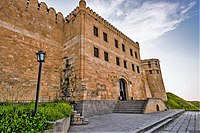
Photo from wikipedia
The paper presents the test experiment to investigate one of UNESCO’s (United Nations Educational, Scientific and Cultural Organization) world heritage objects, an archaeological site in the Naryn-Kala citadel (Derbent, Republic… Click to show full abstract
The paper presents the test experiment to investigate one of UNESCO’s (United Nations Educational, Scientific and Cultural Organization) world heritage objects, an archaeological site in the Naryn-Kala citadel (Derbent, Republic of Dagestan, Russian Federation) hidden under the ground’s surface. The function of the site could be revealed by the muon radiography studies. Several nuclear emulsion detectors were exposed for two months inside the site at a depth about 10 m from the modern surface. The use of nuclear emulsions as probing radiation detectors combined with the potential of modern image analysis methods provides for a uniquely high resolution capacity of recording instrumentation and 3D reconstruction of the internal structure of the investigated object. Here we present the experiment and data analysis details and the first results.
Journal Title: Applied Sciences
Year Published: 2019
Link to full text (if available)
Share on Social Media: Sign Up to like & get
recommendations!